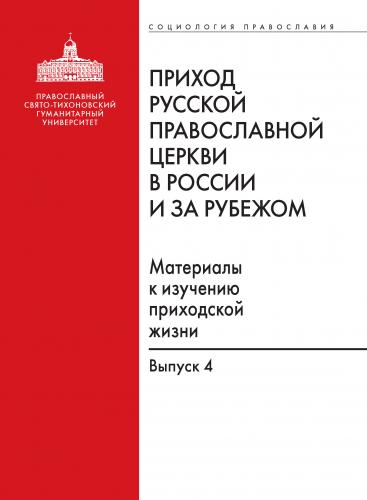The final fourth part of the issue called “Parish and Orthodox Migrant in Scientific Research Studies” is completed by the papers of the following authors:
– A. Krindach, who is famous for his fundamental research study of Orthodoxy in America;
– S. V. Ryazantsev, A. A. Grebenyuk, specialized for a long time and have a lot of publications on the study of the life being of Russian compatriots abroad, including Russian communities in the USA;
– N. S. Erokhova, which article is an analysis of Christian communities of the city of Pittsburgh, PA based on the results of the sociological research made by the Faculty of Social Sciences within the framework of cooperation between St. Tikhon Orthodox University and Theological Seminary of Pittsburgh.
One more article written by Podlesnaya M. A. and Kharchevkina N. N. is based on the translation of not published in Russia book by Peter Berger who considers the phenomenon of American religiosity in comparison with European secularism.
The aim of all these research studies is to provide a scientific foundation for parish research materials and is a sort of a clue to other parts of the issue; they allow us to understand what Orthodoxy in America is and what American communities are today.
One of the last Patriarch Tikhon’s achievements as the Archbishop of Aleutian and North American Archidiocese was the First Orthodox Church Council in America which was convened by St. Tikhon in Mayfield (Pennsylvania) in 1907. A number of serious and actual even today problems were highlighted by St. Tikhon – expansion of Orthodox mission in America, the necessity of elaboration of The Mission Charter, overcoming of dissociation, assistance of poor parishes, unification of all the ethnical orthodox groups despite the differences in performance of ceremonies and services not affect the very core of the Faith. Thus St. Tikhon stressed an importance of manifestation of concern and love towards every parishioner appeared on this land: there was one shepherd and unified flock.
The official farewell of St.Tikhon with his American flock took place on March 17, 1907 on Shrove Sunday. His last divine service in America St. Tikhon made on March 24 in St. Nicholas Cathedral in New York, and on March 26 he returned to Russia. In his farewell communication St.Tikhon asked the assembled people to be strong in possessing the True Orthodox Faith and in spreading it among unconverted people. We hope that this issue will be a small contribution to that mission started by St.Tikhon.
In conclusion we would like to thank the governance of St. Tikhon’s Orthodox University for rendered financial and moral support, as well as all the coordinators of the project living and ministering in different countries of the world, everybody who kindly welcomed us in our research trips.
We also want to tell special thanks to abbot Nikodemus (Balyasnikov) for active participation in our work, especially for organization of the field work at the parish of St. Nicholas Cathedral. Besides, we express thanks to Rev. Hieromonk Eutichius (Dovganyuk), who cordially welcomed us and helped with accommodation in New York. Great thanks to John Burgess, the Professor of Theological Seminary of Pittsburgh, who took care about everything during our staying in Pittsburgh. At last, we would like to express special thanks to Olga V. Trofimova, our critic and text editor, Lidiya V. Rassokhina and all the students of the Faculty of Social Sciences of St.Tikhon’s Orthodox University participated in the process of transcribing the interviews and working with the research materials.
Часть 1
Православие в США: многообразие как особенность американской культуры
Патриаршие приходы в Соединенных Штатах Америки
Иеромонах Никодим (Балясников), клирик Свято-Николаевского патриаршего собора в Нью-Йорке (Московский Патриархат).
«В Америке есть такая присказка: «Что ни улица, то своя Церковь». И это правда! Их даже невозможно классифицировать. Американцы настолько спокойно смотрят на религиозный плюрализм среди населения, что мы для них еще одна Церковь».
Интервьюер: Для начала я хотел бы попросить Вас ответить на несколько личных вопросов. Где Вы родились, сколько Вам лет, какое воспитание получили в семье, какое получили светское и духовное образование?
Иеромонах Никодим: Я родился в Приднестровье, в городе Бендбра. Семья туда попала благодаря нашему деду. Мы сами родом из Мордовии, я мордвин. Но в советское время дед попал туда по распределению, и я там родился. Нужно отметить, что Бендера – это достаточно религиозный город по сравнению с прочим Приднестровьем, потому что там сохранился старый Преображенский собор. Бендеры были под Румынской оккупацией[1], видимо благодаря этому собор остался, не был разрушен. На другом берегу, на левобережье, советский атеистический каток прошелся более капитально, там сохранилось очень мало храмов, и религиозной жизни практически не было.
Мама у меня работала воспитателем в детском саду, отец – водителем скорой помощи, работал в детской больнице. Воспитание в семье получил больше гуманитарное, наверное. Семья была благополучная, со мной росла младшая сестра. Пережили войну 1992 года в Приднестровье[2]. Я думаю, это, безусловно, наложило какой-то отпечаток на дальнейшее мое образование, на мировоззрение. Довольно рано пришлось столкнуться со смертью, со справедливостью. Это все настолько
